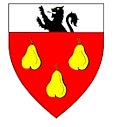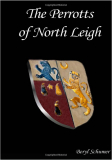
"As far, however, as records can carry us, with the exception of a few who may be able to connect themselves with the Oxfordshire Perrots, there are probably no exisiting male descendants of the ancient Perrots of Pembrokeshire, or who can at least substantiate their claims."
Perrot notes, or some account of the various branches of the Perrott family, Edward Lowry Barnwell, (London: J. Russell Smith, 1867)
| Recent Updates: |
- 19 Mar 2024: Updated the section on family origins
- 20 Jan 2015: Updated the Yorkshire branch
- 25 Dec 2013: Added an additional reference to the miscelleanous Perrot page
- 20 Dec 2013: Added 2 additional wills to the Perrots of Herefordshire & updated the family information
- 03 Dec 2013: Added references to the section on Perrott armorial bearings
- 01 Dec 2013: Updated and corrected the information for the Yorkshire, Worcestershire, Oxfordshire, and KentPerrots
- 24 Nov 2013: Updated and corrected the information for the Carmarthenshire and the Herefordshire Perrotts
- 23 Nov 2013: Updated and corrected the information for the Scotsborough Perrots
- 11 Nov 2013: Updated the historical information for the Baronets and expanded the pedigree
- 08 Nov 2013: Corrected and separated the Northleigh Perrots into the golden and silver pear branches; corrected the children's list for Sir Owen (#12) and Thomas #10), below.
- 07 Jun 2013: Updated the Perrots of Bedfordshire
- 30 May 2013: Added the Oman reference and updated the information accordingly.
- 20 Jun 2012: Added the fictionalized family history by Burke.
- 26 Mar 2012: Updated & corrected the Perrots of Bedfordshire
- 16 Jan 2012: Updated the Perrots of Bedfordshire, and combined with the Huntingdonshire file.
- 02 Jan 2012: Updated the family of Samuel Perrott for the Perrots of Carmarthenshire
- 26 Nov 2011: Updated references & family tree for the Perrotts of Worcestershire
- 24 Jun 2011: Updated information on main page, corrected children list for Sir Owen & Sir John, updated page for Carmarthen, added pages for Kent and Bedfordshire.
- 20 Jun 2011: Small corrections and additions to this page, plus those of the Herefordshire and Scotsborough.
- 15 Jun 2011: Added transcript and copy of a pedigree written ~1500. [MS 227 British Museum]
- 15 Jun 2011: Additions to the Perrotts of North Leigh and new links to references.
- 17 Apr 2011: Corrections to the family tree for the Perrotts of Yorkshire and new links to additional will transcripts.
- 14 Mar 2010: Added details to Sir John Perrot and his parents, based on Turvey 2010.
- 31 Jan 2010: Corrections to the family tree for the Perrotts of Yorkshire and new links to additional will transcripts.
- 01 Jan 2009: Minor corrections to the family trees for the Perrotts of Yorkshire and Worcestershire, based on a newly found reference from 1781.
- 25 Jun 2008: Added two wills of the Northleigh Perrots
- 21 Jun 2008: Updated family trees for the Perrotts of Yorkshire and Worcestershire; added transcripts of wills of the Worcestershire Perrotts
- 04 May 2008: Added the Perrots of Yorkshire
- 03 May 2008: Added text of will of John Perratt Jr. of Barbados, dated 23 August 1746; made corrections the family tree.
- 01 May 2008: Added a page with information on the Perrots of Worcestershire
- 22 Apr 2008: Updated information on Richard Perrot of Virginia, said to belong to the Perrot family of Pembrokeshire, based on the family arms appearing on the seal of his will dated 20 July 1686.
- 22 Apr 2008: Added information on John Bradley, died 1780 in North Carolina, said to be a Perrot descendant based on the seal of his tombstone.
- 22 Apr 2008: Added photo of gravestone of John Perratt, died 1729 in Barbados, containing the Perrot coat of arms.
- 18 Mar 2008: Added a transcript of the will of Francis Perrot of Herefordshire, dated 20 March 1636/7.
|
Any reader of the following pages will note there are many branches-- particularly those established by younger sons, that disappeared from the written record. Many of these are bound to have living male descendants. It is just a matter of finding proof. Case in point, the traditional arms were last awarded in in 1946 to Herbert Edwin Parratt.
Following is an overview of the Perrott family, always best described as a work in progress, and based primarily on the works of:
- Barnwell, Edward Lowry. 1867. Perrot notes, or some account of the various branches of the Perrott family, J. Russell Smith, London.
- Full text available freely from Google Books.
- Nichols, John Gough. 1870. Perrott Notes, In: The Herald and Genealogist. Volume the Fifth. J.G. Nichols and R.C. Nichols, Printers to the Society of Antiquaries, 25, Parliament Street, Westminster, London. Pp 369-376.
- Oman, Sandra. 2002-2012. Adam "le Perot," In: Wales. Welsh Medieval Database Primarily of Nobility and Gentry. In: Welsh Families Project
- Owen, Henry. 1902. Old Pembroke Families in the Ancient County Palatine of Pembroke. Chas. J. Clark, London. 1902), Pp 51-66
- Full text available freely on line
- Turvey, Roger. 2002. A Critical Edition of Sir James Perrot’s ‘The Life, Deedes and Death of Sir John Perrott, Knight’, by James Perrot. Edited, annotated, and introduced by Roger Turvey. Mellen Press.
- Turvey, Roger K. 1988. Final Revision Perrot Family And Their Circle In South West Wales During The Later Middle Ages. Doctoral thesis.
- Turvey, Roger. 2010. Sir John Perrot: The man and the Myth. Separating fact from fiction in the life of this legendary figure. The P-rr-tt Society special publication.
- Turvey, Roger K. 1990. Some minor lines of the Perrot family in south Wales, P-rr-tt Society Family Notes 7:42-47.
Where the sources conflict, Barnwell prevails over Owen, and Turvey over Barnwell on these web pages.
The following accounts of the family origins-- all versions of each other- are spurious and should not be taken seriously:
The main lineage and its branches
Below is the main trunk of the Perrot family, which resided in Pembrokeshire, along with an overview of the family as a whole. The question remains whether the main trunk itself is native to Wales, or a branch of England's first Perrott family in Kent.
Besides the main trunk, there were branches known at Caervoriog, Herefordshire, Oxfordshire (which is separated into the Hill and Church groups), Scotsborough, and Carmarthenshire. The latter's descendants are in Ireland and perhaps Australia. In addition, there are other, less well documented Perrot families in Monmouthshire and elsewhere that are probably related, given they used the same arms.
The Perrots of Bedfordshire, Huntingdonshire and perhaps Worcestershire and Yorkshire most likely split directly off the original family in Kent.
An additional line appears in Barbados, as determined by the use of the traditional Perrot arms. However, reports of this family in Virginia and North Carolina have not stood up to scrutiny and must be considered false.
Family Origins & Overview
Not surprisingly for a 1000-year-old family, its earliest generations are not well documented, and hence are the subject of debate. According to Barnwell, "The exact period when the first of the Perrot family came into Pembrokeshire has not yet been satisfactorily ascertained. In various pedigrees he [Stephen Perrot, first documented in the lineage] is said to have arrived in the time of Henry I. Meyrick assigns a date of 1112 as probable, as in that year Henry is said to have collected all the Flemings and other foreigners in England, and to have settled them between Tenby and Haverfordwest.” What is certain is that a nineteenth century history of the family by Burke is highly fictionalized and not reliable.Two main possibilities have been put forward:
Possibility 1: This family's paternal line is, if not of native Welsh origin, then of early Norman ancestry, arriving during the reign of King Henry I. The evidence in favor has been nicely laid out and explained by Anne Rees, so it won't be repeated here.
Possibility 2: As proposed by Dr. Roger Turvey in 1988, these Perrott's are of Norman origin, arriving during the reign of King Henry III. Pirot-- the putative family founder-- is listed in the Domesday Book as having substantial holdings in 1086. The family had settled in Kent by the reign of King Henry I of England, who died in 1136.
The premise is that the descendants of Pirot eventually gave rise to the Perrotts of Pembrokeshire. The first recorded reference to Perrots in Pembrokshire is from 1290, which is consistent with the fact that the Kent Perots accompanied Henry III to Wales in the 1263, and some may have stayed there to found the Pembrokeshire branch.
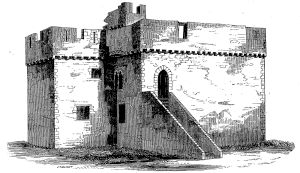
Left: The 13th century Perrot home at Eastington
The Perrots were originally said to be at Iestynton (Eastington), though they were in Popton prior to Instington. About 10 generations later the Pembrokeshire Perrot's also became known as the Haroldstons. Haroldsone is adjacent to the town of Haverfordwest, and sometimes these two names are used interchangably in the genealogy. According to Barnwell, "Peter Perrot, son and heir of John, is sometimes called knight and sometimes esquire. He married Alice, daughter and heir of Sir Richard Harold, knight, of Haroldston, which probably became the primary residence of the 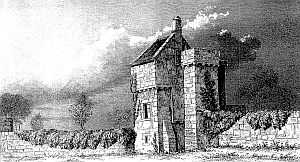 family ... The relicts of Haroldston (see right) are still to be seen near Haverfordwest, and consist of some walls and a tower called ‘the Steward’s Tower,’ .... This tower is the oldest portion that presently remains, but later than the time of Alice Harold, through whom the property came into the Perrot family. Haroldston appears from this time to have been their favourite residence, and formed a portion of the marriage settlement of Mary Barclay, the mother of the Lord Deputy [Sir John Perrott]; but was afterwards surrendered to him, on certain terms, by an agreement dated 4 Edward VI." However, it was John's grandson, Thomas, who moved the family to from Instington to Haroldstone sometime after 1442. family ... The relicts of Haroldston (see right) are still to be seen near Haverfordwest, and consist of some walls and a tower called ‘the Steward’s Tower,’ .... This tower is the oldest portion that presently remains, but later than the time of Alice Harold, through whom the property came into the Perrot family. Haroldston appears from this time to have been their favourite residence, and formed a portion of the marriage settlement of Mary Barclay, the mother of the Lord Deputy [Sir John Perrott]; but was afterwards surrendered to him, on certain terms, by an agreement dated 4 Edward VI." However, it was John's grandson, Thomas, who moved the family to from Instington to Haroldstone sometime after 1442.
Sir John Perrot, the most well known of the lineage, made Haroldston his home until Queen Mary granted him Carew Castle. Again, Barnwell writes, "The subsequent history of the place is obscure. It probably was returned, with the rest of the estates, to Thomas, the Lord Deputy's son, on whose decease the estates were resumed by the crown. It became, however, by some means, the property and residence of Sir James Perrot, the illegitimate son of Sir John, who [lacking male heirs] bequeathed it to Sir Herbert Perrot. It seems to have been subsequently sold by Sir Herbert Perrot or his descendants, as it at present forms no portion of the land inherited from that family by the present Sir John Packington of Westwood.” Barnwell's comments not withstanding, Herbert was a distant cousin of Sir James on the Perrot side, and a second cousin once removed of Sir James' wife. Herbert's father, Robert Perrot of Morton in Herefordshire was Oxford-educated, and produced an "impressively large genealogical chart for which Sir James supplied references pertinent to his own branch of the family."
Barnwell notes that Sir Thomas [the legitimate son of Sir John] was the "last of the Haroldston line," having no male heirs, which would explain why Haroldstone was returned to the crown upon his decease.
More on the family, from Barnwell:
"There was however, a genuine branch of the Pembrokeshire line, which seems to have settled in England in the time of Henry VII. As the house of Haroldstone was a zealous supporter of that king, it is not improbable some of its younger sons may have followed him into England, after the battle of Bosworth Field [Next to last battle of War of the Roses, when Henry Tudor defeated Richard III; 22 August 1485; Sir Thomas Perrott of Haroldston, Pembrokeshire, fought on the Lancastrian side], with a view to improve their fortunes. The identical connecting link, however, cannot be made out satisfactorily from the Welsh or other visitations. In the English ones this family is simply described as of the Pembrokeshire line. In Lee's Oxfordshire visitation, it is given 'Owen Perrot, a third brother of the house of Pembrokeshire.' This family finally settled at North Leigh, near Oxford, where William, the last of the line, died in 1765."
"It was however in Pembrokeshire that the family flourished so extensively and so vigorously from a period soon after the Norman invasion till the reign of Elizabeth. By marriages considerable estates were successfully acquired; in which judicious practice they were followed by others of the same class..."
Why pears?
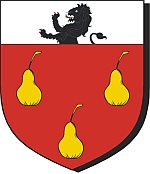 The arms (i.e., the depictions placed in the central shield in a coat of arms) used by Perrot family members for at least 600 years is described as "gules three pears or on a chief argent a demi-lion rampant issuant sable armed and langued gules" -- that is, 3 golden pears on a red background, below a silver (white) area with the top half of a black lion standing on his hind legs, and showing a red tongue. As arms came into common use, one of the predominant ways designs were chosen was to pick objects that phonetically resembled the name of the bearer. In this case, a golden pear (pear or) sounds like the French pronunciation of Perrot, the 't' of which is silent. The practice was known as canting arms, and the Perrot arms are one of the best examples. This practice was particularly useful in the days when illiteracy ran high. The arms (i.e., the depictions placed in the central shield in a coat of arms) used by Perrot family members for at least 600 years is described as "gules three pears or on a chief argent a demi-lion rampant issuant sable armed and langued gules" -- that is, 3 golden pears on a red background, below a silver (white) area with the top half of a black lion standing on his hind legs, and showing a red tongue. As arms came into common use, one of the predominant ways designs were chosen was to pick objects that phonetically resembled the name of the bearer. In this case, a golden pear (pear or) sounds like the French pronunciation of Perrot, the 't' of which is silent. The practice was known as canting arms, and the Perrot arms are one of the best examples. This practice was particularly useful in the days when illiteracy ran high.
Along with the arms of the 3 pears, the family motto was "Amo ut invenio" - 'I love to discover' or 'I love as I find.' Here are some sample coats, showing the different ways the traditional Perrot shield and crest were incorporated into the coats of arms of different Perrot individuals across the ages.
The 3-pear design supplanted the original family design, described as Quarterly, per fess, indented or and azure. That is, divided into fourths in gold and blue, with a saw-toothed edge separating the upper and lower halves. See examples of designs used by this and other Perrott families.
The main lineage
Transcript and copy of a pedigree written ~1500. [MS 227 British Museum]

00. Adam "le Perot" (b ~1030)
- Possibly corresponds to the Pirot who settled in Kent
- If so, partipated in the Norman conquest of 1066
- The 1st 4 generations below are considered fictitious by Turvey
01. Stephen Perrot (b ~1070, Pembrokeshire, Wales; d aft 1112)
- Called Trevor in some pedigrees; said to be the son of either Richard or Adam, but no proof
- If he was not of Welsh origin, he may have arrived when King Henry I settled Flemish immigrants in Wales.
- Dwnn refers to him as "Syr Stephen Perott the first Norman settler in Pembrokeshire".
- Married Ellynor (b ~1100), Lady of Iestynton, Rhoscrowdder, Pembrokeshire, Wales, daughter and co-heir of Meirchion Ap Rhys, fourth in descent from Howel Dda (King of Wales, died 948). Her sister Alice married Sir Matthew Wogan
- Daughter Eleanor, who married Einion Vawr of Coed
- Son, Andrew, see #2 below
02. Sir Andrew Perrot (b ~1130, Iestyngton)
- Married Janett Mortimer, daughter of Ralph Mortimer (d 1246), lord of Wigmore, Justice of Gwynedd, and Gwladys, daughter of the Princess Joan and Llewelyn ap Yorwerth (d 1240), King of South Wales
- Janet Mortimer was granddaughter of Joan, illegitimate daughter of King John. Joan married Llwelyn ap Yorwerth in 1202, which means Janet would not have been of marriageable age before 1235-40. This would require more than a century between the marriage of Stephen, and that of his son, Andrew.
- According to Barnwell, "This difficulty, it has been suggested, may partially be removed by supposing that one generation has been omitted, and that Andrew was the grandson, not the son of Stephen; but there appears to be no authority for such a statement, or any other grounds than the difficulty presented by the dates."
- Said to have built Narbeth castle
- More details on Narberth & the Perrot role there, by Fenton, R. 1811. A Historical Tour through Pembrokeshire. Pp 306-309.
- Children:
- Daughter Catrin (Catherine). Marries her cousin, Caradog (Cradoc) ap Howell of Newton, near Milford in Rhos. Sir Richard Newton, 7th in descent from this marriage, marries Emma, daughter of Sir Thomas Perrot and Alice Picton, his wife.
- Daughter Elsbeth (Elizabeth), marries Dafydd (David) Wynter, b ~1250, Caerfyrddin Sain Pedr, Carmarthenshire, Wales
- Son William, see #3 below.
03. William Perrot (b ~1170, Iestynton)
- Married Margaret, a daughter and coheir of Sir Walter Hereford/Hartford, and who is said have brought to her husband nine inheritances
- Other accounts have his wife as Jane
- Son Peter, see #4 below.
04. Peter Perrot (b ~1200, Iestynton)
- Married Mabli (Mary), a daughter and co-heir of Harry Kynaston (Caniston), in the county of Pembroke
- Son Stephen, see #5 below.
= = = = = = = = = = = = = = = = = = = = = = = = = = = = = = = = = = = = =
The historical record starts here. Prior generations lack documentation (as per Owen, 1902, and Turvey, 2002). Although they are undocumented, they are nonetheless mentioned in Lewys Dwnn's Heraldic Visitations of Wales and Part of the Marches Between 1586 and 1613, volume 1, pp 74, 89, 90, 134, 135, 165, & 168.
= = = = = = = = = = = = = = = = = = = = = = = = = = = = = = = = = = = = =
05. Stephen Perrot (b ~1230 - d ~1338) of Popton (Popetown)
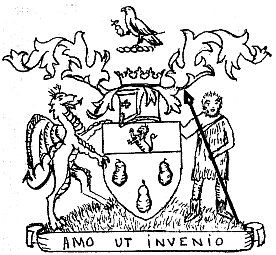
- Birthdate comes from trying to fit him to a ficticious father! He was probably b ~1260.
- In one scenario favored by Turvey, he was the son of Sir Ralph Perot V (~1236-1305) from Kent, who "served in the campaign in Wales under Henry III in 1257, attended the King in France in 1259, and was summoned for service in Wales in 1263."
- 1307- is a juror at Pembroke
- 1324- held half a knight's fee at Popton for the earl
- 1327- indicted for conspiracy against Richard de Barri
- Turvey: "One of around a dozen principal fief holders of the Earl of Pembroke, established himself and his family by virtue of an advantageous marriage with Mabli, daughter and heiress of John Castle(de Castro/Castell) of Castleton, though whom he inherited, what later was to form the nucleus of the Perrot estates, the house and manor of Popton."
- Oldest son, John- see #6 below
- Son Richard-- 19 acres of land in Graveshill granted to him by his father
- Son Peter moves to Scotsborough, giving rise to that line of Perrots. "This property, situated near Tenby, probably came by marriage. The line, however, ceased [after 9 generations] in Catherine, sole heiress, who married Thomas ap Rhys of Richardstone, high sheriff of Pembrokeshire in 1582. A branch of this line became the Herefordshire Perrots.
- Daughter Joan, married William Benegar.
- Daughter Letis (Lettys), married John ap Gronwy of Kil y sant (Ieuan ap Goronwy, b ~1300) of Llethr Neuadd, Llanllawddog, Carmarthenshire, Wales.
- Daughter Catherine, married to Evan ap Gwylym (Ieuan ap Gwilym, b ~1230) of Cemais cantref, Pembrokeshire, Wales.
06. John Perrot (b ~1270; d 13 January 1349) of Popton
- Turvey: May have been one of the first victims of the Black Death
- Married Jane/Janet/Joanna Joyce, daughter of Sir John Joyce, of Prendergast, sheriff of Pembrokeshire in 1333
- Son Peter - #7 below
- Daughter (or granddaughter?) Alice married Stephen Malefant
- Daughter Isolda married William Benegar. She was guardian during Peter's minority to a messuage [house with its land and outbuildings] and a carucate [the amount of land a team of eight oxen could plow in a year] of land held by socage tenure [land held in return for produce or service] at Eastington. Peter sued in 1373 to get the profits from that land.
07. Peter Perrot (b ~1300; d 1378)
- Turvey: "was most likely responsible for the building and relocation, of the family to Eastington (Istington), a fortified manor house near the shore of Angle Bay."
- Referred to as both esquire and knight
- Married Ales (Alice) daughter of Sir Richard Harold of Haroldston and Eleanor Hill
- Son Stephen - #8 below
- Daughter Catherine (b ~1330), married Owain ap Robert (~1300 - aft 1363) of Cemais cantref, Pembrokeshire, Wales
- Daughter Joan (b ~1330), married Thomas Wogan (b ~1330) of Cas-wis, Pembrokeshire, Wales
08. Stephen Perrot (b ~1350; d ~1428) of Eastington
- Upon death of his father, his uncle John Harold (d 1839) became his guardian.
- Married Ellen (b ~1365), daughter heir of Sir John Howell of Woodstock, Ambleston, Pembrokeshire, Wales.
- Son Thomas- #9 below.
- Daughter Annes (b ~1380), either married William White (b ~1370) of Rhos cantref, Pembrokeshire, Wales; or was second wife of Roger Marychurch. His first wife was Jane, daughter of David Perrot of Scottsborough
- Daughter Alice (b ~1380), married Henry Malefaunt/Malephant (b ~1350) of Cydweli, Carmarthenshire, Wales
- Next married Margaret, daughter of Stephen Stepney
- Son Henry
- From Barnwell "Stephen Perrot was alive, and father of an adult son, in 1403, as he and John Castlemartin are named in Sir Francis A'Court's commission to be receivers of money raised for Owen Glendowers [the medieval Welsh nationalist leader who disappeared in about 1415] benefit." I.e., (Turvey): "He remained loyal to the Crown during the Welsh rebellion led by Owain Glyndwr, with whom he negotiated on behalf of the people of Pembrokeshire, a truce in 1405."
09. Sir Thomas Perrot (cal 1382 - 10 April 1460 in Bristol) of Eastington and Haroldston
- Moved family to Haroldston sometime after 1442
- Turvey: "Knighted sometime between 1442 and 1446, Perrot occupied high office in the earldom for more than twenty years, serving as sheriff and steward of the county." Either he or his son was employed as one of the councillors of Jasper Tudor. Note that although Sir Thomas was said to be in the battle of Mortimer's Cross, 2 February 1461, he was already dead, so it had to be his son, Thomas, who appears in the roster.
- Barnwell: "To this Sir Thomas, in connexion with Henry Malefant, a commission (14 Nov., 4 Hen. IV) was issued by Sir Francis A'Court to raise certain sums in Carew and other places, and to pay £200 in silver to Owen Glendwr, on condition of a cessation of hostilities. The money was first to be transferred to Stephen Perrot and John Castlemartin. The Henry Malefant here mentioned is probably the nephew of Stephen Malefant, who married Alice Perrot.
- Married Alice (b ~1400; d 31 April 1441), daughter of Sir John ap William ap Thomas ap Sir William Picton (aka John Picton, d 1440) ca 1440, by whom diverse descents of inheritance came to the Perrot family
- Next married Joane, daughter of John Arnold and widow of Llywelyn Warren of Warren. Her deed is dated 1465.
- Son Thomas- see #10 below.
- Son Stephen, d 20 June 1461.
- Daughter Emma, wife of Sir Richard Newton (aka Cradock; d 1444), of Newton Noyes, Llanstadwel, Pembrokeshire, Wales, who became Lord Chief Justice of the Common Pleas in 1439
- Daughter Margaret, second wife of Gruffydd ap Nicholas, who died during the battle of Mortimer's cross, fighting for the Yorkists. She next married John Vytere.
- Daughter Joan 1st, married Gruffudd ap Nicolas (b ~1400) of Llandeilo Fawr, Carmarthenshire, Wales; d. 2 Feb 1461, Battle of Mortimer's Cross, Herefordshire, England.
- Daughter Joan 2nd, married Sir Harry Wogan of Cas-wis, Pembrokeshire, Wales; d 1469, Battle of Edgecote Field, Banbury, Oxfordshire, England.
- Daughter Jane/Jonet, married Philip Eliot of Erwer, Amroth, Pembrokeshire, Wales.
- There were 3 Jane Perrots from 3 straight generations who married into the Elliott family, generating confusion.
- Daughter Annes, married Hywel ap Dafydd (b ~1400) of Gwernant, Troed-yr-aur, Cardiganshire, Wales.
- Daughter Agnes, married William Warren of Warrington
- Daughter Ellen, maried first Richard Wyriott of Orielton, Hundleton, Pembrokeshire, Wales; then Lewis Davy
- Son John, possibly married to Ellen; fate unknown. Turvey (1990) thinks is the John who founded the Perrot family in Woodstock.
- Son Henry- owned Caervoriog. Married Isabella Laugharne of Pembrokeshire, Wales. His widow returned it to Haroldston.
- Daughter Annes (b ~1430) married William Waring, (b ~1400; d 1484) of Tre-wern, Nyfer, Pembrokeshire, Wales
- Son William of Tallacharn in Caemarthenshire. His existence is known because there was an inquisition into his possessions in 2 Elizabeth. A descendant of this line might be the John Perrot of Haverfordwest who matriculated in Oxford in 1772. Perhaps other descendants of this branch are still around.
- Son Stephen Perrot
10. Thomas Perrot (b ~1398; d 23 July 1474), Esquire of Istingston and Haroldston
- Since Sir Thomas was already dead by the time the battle of Mortimer´s Cross took place on 2 February 1461, this must be the Thomas Perrot listed in the battle roster. Mortimer´s Cross was one of the battles of the Wars of the Roses. The Yorkists, led by Edward Mortimer, earl of March, defeated the Lancastrian forces led at the request of the queen, Margaret of Anjou, by Jasper Tudor, son of the earl of Pembroke. Mortimer´s Cross is located in the county of Herefordshire, on the border between Wales and England.
- First married Janet/Joan, daughter of John Gwys (Wise/Guise), Esq.
- Son William, see #11 below
- Daughter Jane/Jonet, married John Elliott (b ~1450) of Erwer, Amroth, Pembrokeshire, Wales
- Next married Isabella, daughter of Sir Henry Wogan (d 1475) of Cas-wis (Wiston), Pembrokeshire, Wales
- 1644- dispute with Priory of Haverfordwest, over services at church of Haroldston, resolved in his favor.
- 1645- is awarded lands in the Lordship of Haverford
- Son Mathew-- probably the (illegitimate?) son who lived in Cheriton
- Son John-and his son John, moved to Woodstock and then Haverford West. The younger John had been said to have founded the branch in Herefordshire, but the discovery of the NWL 135 pedigree roll makes it clear that the John who moved to Herefordshire was the son of a William Perrot from Scotsborough. Instead, John of Woodstock is the most likely person to have given rise to one of the Perrot families of Northleigh.
11. Sir William Perrot (~1433 - 7 June 1503) of Haroldston
- 1496- appointed sheriff within the Lordship of Haverford by Henry, Duke of York, Earl of Pembroke and Lord of Haverford (and later king)
- Knighted 1501, following marriage of Prince Arthur
- Married Joanna (b ~1430; d 11 November 1504), daughter of Sir Henry Wogan of Wiston, whose mother was a sister of William Herbert, the 1st Earl of Pembroke by that name.
- Son Owen- #12 below
- Son Jankyn (Jenkin/John) Perrot of Caervoriog, inherits lands of Henry Perrot of Caervoriog. He was married to Elsbeth Wiriot (Elizabeth Wyrriot).
- Jane Perrot (b ~1500). Married Sir James Bowen (James ab Owain), Knight, of Pentre Ieuan, Nyfer, Pembrokeshire, Wales.
- Alice Perrot (b ~1500). Married John Lloyd (John ap Jenkin "Llwyd Fychan"), of Dinbych-y-Pysgod, Pembrokeshire, Wales.
- Anne Perrot (b ~1500). Married Thomas White of Rhos cantref, Pembrokeshire, Wales.
- Daughter Mawd/Maude (b ~1459) - married ~1485 to William Adams,(b ~1455) of Patrickchurch, St. Mary, Penfro, Pembrokeshire, Wales
- Daughter Joyce- married Janbyn ap Howell (Jenkin ap Hywel), Jr. of of, Trefdraeth (Newark), Pembrokeshire, Wales
- Daughter Anne-
- Daughter Isabella-
- Daughter Alicia- married Richard Tucker (b ~1470) of Sealyham, Llandudoch, Pembrokeshire, Wales
- Daughter Margred/Margaret- married William Vaughn (William ap Gruffudd "Fychan") of Cilgerran (Kilgerran), Pembrokeshire, Wales
- Has granddaughter Jane, who married John Perrot, the last of the Scotsborough Perrots, and who was sheriff in 1551. Their daughter was Catherine who passed on the Scotsborough estate to John ap Rhys of Richardstone
- He and wife are buried in the Priory Church of St. Thomas the Martyr at Haverford
- Will proved 7 June 1503
12. Sir Owain (Owen) Perrot (d 1521) of Haroldston
- Married Catherine Poyntz, daughter of Sir Robert Poyntz of Iron Acton, Gloucestershire, whose mother was a daughter of Anthony Wydeville, Baron Scales (1460) and the Earl of Rivers and Scales (1569). He was brother in law to Edward IV. Based on the Perrot V Perrocke lawsuit, he only had 4 sons.
- Knighted 1513
-
- Daughter Elizabeth (Elsbeth, b 1517), married ~1538 to Thomas Audley (b ~1513) of St. Ives, Cornwall, England (not listed by Turvey)
- Oldest son Robert, heir, died young (d 1522) & with no issue. As his father died while Robert was a minor, Robert was placed in the custody of 2 knights.
- Son Thomas, see #13 below
- Daughter Mary, first wife of Gryffyth (Gruffudd) White
White, of Henllan, Rhoscrowdder, Pembrokeshire, Wales
- Richard of Brook near Claymore - Illegitimate, and had illegitimate son, Richard
- Ruus(Rhys/Rice) Perrott. Usually confused with another Rice (d. 1571), who lived in Sandwich, Kent. Said to have Tutored King Edward VI in Greek. Became a bailiff of Sandwich in 1557, its M.P. in 1563, then its mayor 1565-66. He was also bailiff and verger for Sir Thomas Cheyney.
- 4th son, John Perrot (d ~1560s) started the family branch in Carmarthen. The Golden Grove pedigree shows Ruus with the family of John.
- A son Edward is sometimes listed
13. Thomas Perrot (b 1505; d Sep 1531), Esquire of Haroldston
- Turvey: Upon death of Sir Owen and his son Robert, the teenage Thomas and his younger brother Edward, "became, upon purchase from the Crown, the wards of Maurice, Lord Berkeley. Berkeley subsequently arranged a match between his own niece and ward Mary, with Thomas, and in event of his death, with Edward."
- 1526 - Married Mary (b 1510/11), a daughter and heir of James Berkeley, Esq., the second son of Lord Maurice Berkeley, squire of King Henry VIII
- Daughter Jane (b ~1525), marries William Phillips (b ~1525; d 14 Mar 1572/3) of Picton, Slebets, Pembrokeshire, Wales
- Daughter Elizabeth married John Price/Pryse (John "Wyn" ap Richard),of Gogerddan in Trefeurig, Llanbadarn Fawr, Cardiganshire, Wales
- Son John, see #14 below
14. Sir John Perrot (b between 7 & 11 Nov 1527 - 3 November 1592; will dated 3 May 1592)
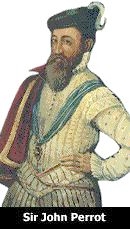
- Probably born at Haroldston,near Haverfordwest
- Completes secondary education at Cathedral school at St. David's
- 1546- moves to London, as apprentice to Sir William Paulet, Lord Treasurer of England
- 1549- courtier in the royal Court
- Knighted 1549
- 1551- becomes sheriff of Pembrokeshire
- 1558- is given Carew Castle
- 1560/1, 1570/1 & 1575/6 - is mayor of Haverfordwest
- 1571-3 appointed Lord President of Munster
- 1574- appointed to the Council of Wales and the Marches
- 1584-8 appointed Lord Deputy of Ireland
- 1589- appointed to the Privy Council
- 1591- arrested for treason and taken to Tower of London
- Buried 10 Nov 1592, Tower of London, church of St. Peter Ad Vincula
- Married (ca 1550) first Anne Cheyney (d September 1553, due to childbirth), the daughter of Sir Thomas Cheyney (d 1558), Lord Warden of the Cinque Portes and sister to Lord Henry Cheyney. Thomas Cheyney also served as Privy Councillor and treasurer to the household of Henry VIII
- Son Thomas, see #15 below
- Daughter Elsbeth, married Alban Lloyd (b ~1570) of Trefeugan, Llanhywel, Pembrokeshire, Wales
- Marries second Jane, widow of Sir Lewis Pollard and daughter of Hugh Pruet/Prust of Thorney, Devonshire, England
- Second son William (died unmarried at St Thomas Court, near Dublin on 8th July 1597)
- Daughter Lettice, who married, first, Rowland Lacharn (Laugharne) of Sain Ffred, Pembrokeshire, Wales; secondly, Walter Vaughan (d 1597) of Y Gelli-aur Golden Groves), Llanfihangel Aberbythych, Carmarthenshire, Wales; and thirdly, Sir Arthur Chichester, Baron Chichester of Belfast, Antrim, Northern Ireland, and Lord Deputy of Ireland
- Daughter Ann, married Sir John Philips, nephew of William Phillips, and first baronet of Picton. Their daughter married Sir Francis Annesley Viscount Valentia and Baron MountNorris. The Annesley family descends from four of the six sons of Edward III. In the biographies of Sir Francis Annesley it is stated that he was firstly butler to Sir Arthur Chichester then later a very good friend (and nephew by marriage) to Dorothy Phillips, the niece of Arthur Chichester and Lettice Perrott.
- Besides these he had a number of illegitimate children. Some of the others were:
- With Sybil Jones (ferch Rhys):
- James, see #16 below,
- Mary, who married Dafydd Morgan of Y Fenni, Monmouthshire, Wales, described as a gentleman
- John, b ~1565. In the Inner Temple Register, there is an entry, dated 5 June 1583--"John Perot, of Haryve, Co. Pembroke, 3rd son of John Perot, Knight". Possibly also the son of Sybil Jones. He died without issue.
- With Elizabeth, daughter of Elizabeth, daughter of Sir Christopher Hatton [later enemy of Sir John]
- Elsbeth, who married Hugh (Huw) Butler of Johnston, Pembrokeshire, Wales
15. Sir Thomas Perrot (Sep 1553 - 1594)
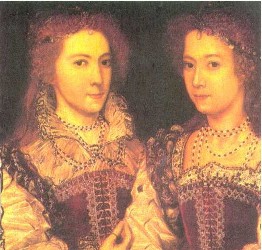
- Knighted in Ireland 1578/9 by Sir William Drury
- Mayor for Haverfordwest in 1586
- M.P. for the county in 1593
- Married 1583 to Lady Dorothy Devereaux (c 1565 - 1619), who died 3 August 1619 (pictured with her sister, Penelope. Dorothy is on the left). She was a sister of Robert, second earl of Essex (1567 - 1601, and favorite of Queen Elizabeth I), and daughter of Walter Devereaux (1514 - 1576), first earl of Essex. Apparently the marriage took place against the Queen's wishes
- Son Roland or Robert (b ~1590 - d bef 1597)
- Daughter Dorothy-- her existence is certainly fictional. She is said to have married her father's kinsman, James Perrot of Wallingford, another fictional character.
- Daughter Penelope. First married famed astronomer Sir William Lower in 1601, and second, Sir Robert Naughton (d Mar 1634/5), one of the biographers of Sir John, and Secretary of State to James I.
- Barnwell: "With Penelope Perrot terminated the main line of the Pembrokeshire Perrots."
16. Sir James Perrot (1571 - 4 February 1636)
- Knighted in 1603
- Illegitimate half-brother to Sir Thomas, and son of Sibil Jones of Radnorshire.
- One of the original investors for the Virginia Company, which settled Jamestown
- Married Mary (d May 1639), daughter of Sir Thomas Ashfield of Buckinghamshire.
- Daughter Cicil. James Perrott, Knight, and Cicil, daughter of James Perrott, are among the folks cited as "freehold tentants of this town, because they did not appear at the Court of View of Frankpledge but defaulted, are amerced seven shillings each" on 3 May 1604 in Newport, Pembrokshire.
- Wills his estate to Sir Herbert Perrot (d 1683) of Morton-on-Lugg, in Herefordshire, son of Robert Perrot (d 1658) of Morton in Herefordshire.
- Sir Herbert's mother (Fortuna Tompkyns) and Sir James' wife, Mary Ashleigh, were 1st cousins 1x removed.
- Buried in St. Mary's chapel, Haverfordwest
Comments? Corrections? Additions? Please write.
Visitors since 01 October 2018: 

 . All information on this and other pages within the p-rr-tt.org.uk/3Pears/ domain is copyrighted. Feel free to copy and share the information, but please abide by the terms and conditions below.
Creative Commons Attribution-Noncommercial-Share Alike 3.0 United States License. Information and data obtained from on pages within the /p-rr-tt.org.uk/3Pears/ domain must be attributed to the P-rr-tt Family Genealogy by DNA Project as outlined in the Creative Commons License. Please include the date when the material was accessed (information changes rapidly!), and please notify an administrator when using data for public or private research released in a public forum. . All information on this and other pages within the p-rr-tt.org.uk/3Pears/ domain is copyrighted. Feel free to copy and share the information, but please abide by the terms and conditions below.
Creative Commons Attribution-Noncommercial-Share Alike 3.0 United States License. Information and data obtained from on pages within the /p-rr-tt.org.uk/3Pears/ domain must be attributed to the P-rr-tt Family Genealogy by DNA Project as outlined in the Creative Commons License. Please include the date when the material was accessed (information changes rapidly!), and please notify an administrator when using data for public or private research released in a public forum.

|
